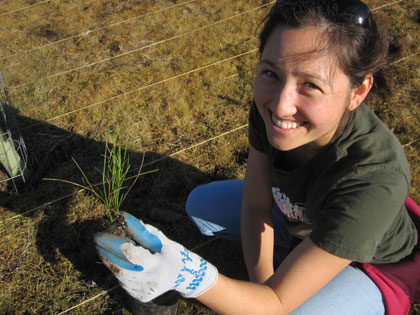Project GROW to plant 10,000 native grass “plugs”

Project GROW, short for Gathering to Restore Oak Woodlands, was back in action at the Bouverie Preserve last month when Sonoma Valley High School students visited to begin planting some 10,000 native grass plugs at the eight-acre oak woodland restoration site. Bouverie Preserve is part of the Audubon Canyon Ranch, a leader in conservation science, habitat protection and restoration, and hands-on environmental education programs for children and adults.
Grasses planted included purple needlegrass (Nassella pulchra), blue wildrye (Elymus glaucus) and California oniongrass (Melica californica), all of which are common native grasses species found in Sonoma County. In addition to providing habitat for species, native perennial grasses and grasslands are an important component of the oak woodland ecosystem. Unfortunately, native grasses have been largely eliminated in California due to competition with invasive exotic annual grasses. Native grasses have also disappeared due to cultivation, urbanization, fire suppression and over-grazing.
According to Jeanne Wirka, resident biologist at Bouverie Preserve of Audubon Canyon Ranch, former president California Native Grasslands Association, author and expert on native grasses, grasslands and the grass understory in oak woodlands are an incredibly important ecosystem in California, covering approximately 25 million acres or about one-quarter of California. Additionally, 90 percent of the animal species considered rare or endangered in California rely on grassland for some portion of their lifecycle.
“When we talk about habitat restoration, most of us picture big trees and large animals,” Wirka said. “But, it is the understory – the soil and grasses and flowers beneath those trees – that support the majority of the biodiversity in ecosystems. The Project GROW field day will teach students about the important ecological function of California’s native grasses, while also restoring native habitat.”
“Involving high school students in habitat restoration multiplies the impact of the project. Participating students are seeing the real-life applications of their science class. Not only is there transformation on the ground, but each student develops a personal connection to this place and the success of this project,” said Nina Suzuki, Statewide SLEWS Director, Center for Land-Based Learning.



